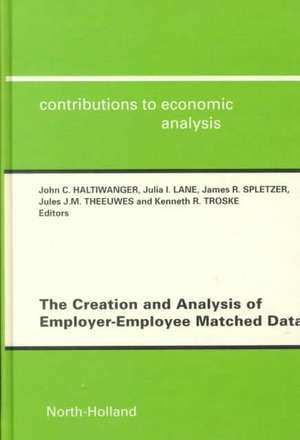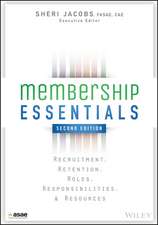The Creation and Analysis of Employer-Employee Matched Data: Contributions to Economic Analysis, cartea 241
Autor J. Haltiwanger, J. R. Spletzer, J. Theeuwesen Limba Engleză Hardback – 12 sep 1999
(1) The analysis of linked employer-employee data.
The basic finding of this and the next section is that the firm matters a good deal in explaining the differences in earnings, productivity, and work experiences of individual workers. Linked data allow the researcher to disentangle the firm effects from the worker effects.
(2) Econometric issues involved with the analysis of such data.
Creating and analyzing employer-employee matched data sets presents a number of new econometric problems that are not present in standard micro-data sets containing just workers or just employers. However, these data also offer us a unique opportunity to examine the effects of some of the econometric problems involved in using the other data sources. The chapters in this section address both of these issues. The first two chapters examine new econometric issues involved in the creation and use of matched data sets, while the second two chapters use matched data to examine possible problems with cross-sectional or panel data on workers. The results from each of these chapters will be valuable to all empirical researchers, regardless of whether they are using employer-employee matched data or more standard cross-sectional or panel data sets.
(3) Ongoing efforts aimed at creating large-scale linked employer-employee data.
The last section of this book describes four recent efforts at creating linked employer-employee data through surveys of firms and individuals. The first two chapters describe an "employers first" methodology of creating linked employer-employee data, and the last two chapters describe an "employees first" methodology. The two "employees first" surveys described here are, as far as known, the only two large-scale surveys in production that follow this design. Each of the four chapters in this section describes details about the design and field operation of the survey that will be indispensable to others who might want to create or analyze linked employer-employee survey data.
The 23 chapters in this book provide a glimpse into the future of labor economics and industrial organization. It can be said that labor economics and public policy around the world has been dominated over the past several decades by quantitative analyses based upon public-use US micro-data. In the future, it is very likely that economics and social policy in the United States and elsewhere will depend on quantitative analysis based on linked employer-employee micro-data currently residing in all continents of the world.
Din seria Contributions to Economic Analysis
- 9%
 Preț: 802.39 lei
Preț: 802.39 lei - 23%
 Preț: 1071.35 lei
Preț: 1071.35 lei - 23%
 Preț: 1023.59 lei
Preț: 1023.59 lei - 23%
 Preț: 932.12 lei
Preț: 932.12 lei - 23%
 Preț: 1258.06 lei
Preț: 1258.06 lei - 23%
 Preț: 1125.47 lei
Preț: 1125.47 lei - 23%
 Preț: 1072.71 lei
Preț: 1072.71 lei - 23%
 Preț: 1134.25 lei
Preț: 1134.25 lei - 23%
 Preț: 1025.01 lei
Preț: 1025.01 lei - 23%
 Preț: 928.43 lei
Preț: 928.43 lei - 23%
 Preț: 1327.58 lei
Preț: 1327.58 lei - 23%
 Preț: 1090.22 lei
Preț: 1090.22 lei - 23%
 Preț: 1196.60 lei
Preț: 1196.60 lei - 23%
 Preț: 928.84 lei
Preț: 928.84 lei - 23%
 Preț: 1061.82 lei
Preț: 1061.82 lei - 23%
 Preț: 1113.58 lei
Preț: 1113.58 lei - 23%
 Preț: 874.46 lei
Preț: 874.46 lei - 19%
 Preț: 673.76 lei
Preț: 673.76 lei -
 Preț: 333.43 lei
Preț: 333.43 lei - 23%
 Preț: 1264.34 lei
Preț: 1264.34 lei - 23%
 Preț: 1323.45 lei
Preț: 1323.45 lei - 23%
 Preț: 1261.24 lei
Preț: 1261.24 lei - 23%
 Preț: 1099.44 lei
Preț: 1099.44 lei - 23%
 Preț: 1149.25 lei
Preț: 1149.25 lei - 23%
 Preț: 836.47 lei
Preț: 836.47 lei - 23%
 Preț: 854.99 lei
Preț: 854.99 lei - 23%
 Preț: 1125.37 lei
Preț: 1125.37 lei - 23%
 Preț: 932.57 lei
Preț: 932.57 lei - 23%
 Preț: 1266.20 lei
Preț: 1266.20 lei - 23%
 Preț: 1018.90 lei
Preț: 1018.90 lei - 23%
 Preț: 1204.17 lei
Preț: 1204.17 lei - 23%
 Preț: 1299.72 lei
Preț: 1299.72 lei - 23%
 Preț: 1221.55 lei
Preț: 1221.55 lei - 23%
 Preț: 1134.89 lei
Preț: 1134.89 lei - 23%
 Preț: 928.43 lei
Preț: 928.43 lei - 23%
 Preț: 930.35 lei
Preț: 930.35 lei - 23%
 Preț: 1028.12 lei
Preț: 1028.12 lei - 23%
 Preț: 895.88 lei
Preț: 895.88 lei - 23%
 Preț: 1096.14 lei
Preț: 1096.14 lei - 23%
 Preț: 999.71 lei
Preț: 999.71 lei - 23%
 Preț: 1052.38 lei
Preț: 1052.38 lei - 23%
 Preț: 1045.56 lei
Preț: 1045.56 lei - 23%
 Preț: 1255.61 lei
Preț: 1255.61 lei - 23%
 Preț: 1076.51 lei
Preț: 1076.51 lei - 23%
 Preț: 1042.59 lei
Preț: 1042.59 lei
Preț: 1398.42 lei
Preț vechi: 1816.13 lei
-23% Nou
Puncte Express: 2098
Preț estimativ în valută:
267.58€ • 279.38$ • 221.46£
267.58€ • 279.38$ • 221.46£
Carte tipărită la comandă
Livrare economică 05-19 aprilie
Preluare comenzi: 021 569.72.76
Specificații
ISBN-13: 9780444502568
ISBN-10: 0444502564
Pagini: 628
Dimensiuni: 156 x 234 x 33 mm
Greutate: 1.05 kg
Ediția:New.
Editura: Emerald Group Publishing Limited
Seria Contributions to Economic Analysis
ISBN-10: 0444502564
Pagini: 628
Dimensiuni: 156 x 234 x 33 mm
Greutate: 1.05 kg
Ediția:New.
Editura: Emerald Group Publishing Limited
Seria Contributions to Economic Analysis
Cuprins
Introduction. Analysis with Employer-Employee Matched Data. Firm Effects on Wages. Individual and firm heterogeneity in compensation: An analysis of matched longitudinal employer-employee data for the state of Washington (J.M. Abowd et al.). Determinants of pay in the Italian labor market: Jobs and workers (P. Casavola et al.). Discrimination or individual effort? Regional productivity differentials in a large Italian firm (A. Ichino, P. Ichino). Compensation policies and firm productivity (J.S. Leonard et al.). Technology and skill upgrading: Results from linked worker-plant data for Finnish manufacturing (J. Vainiomäki). The impact of a disabling workplace injury on earnings and labor force participation (R.T. Reville). Wage Differentials in Firms. Why are racial and ethnic wage gaps larger for men than for women? Exploring the role of segregation using the new worker-establishment characteristics database (K. Bayard et al.). Employer wage differentials in the United States and Denmark (S.G. Bronars et al.). Do higher wages reflect higher productivity? Education, gender and experience premiums in a matched plant-worker data set (T. Hœgeland, T.J. Klette). Sources of earnings dispersion in a linked employer-employee data set: Evidence from Norway (K.G. Salvanes et al.). Firm Effects and Worker Turnover. The employer's wage policy and wage turnover (E. Barth, H. Dale-Olsen). Separations at the firm level (G.J. van den Berg et al.). On the incidence of layoffs (W.H.J. Hassink). The effect of worker reallocation on the earnings distribution: Longtitudinal evidence from linked data (J. Lane et al.). Past-year employment, slow reemployment, and earnings losses: The case of worker displacement in France (D.N. Margolis). Econometric Issues Involved in Analyzing Matched Employer-Employee Data.














